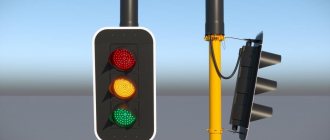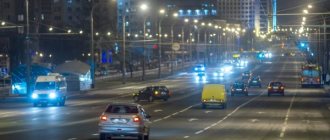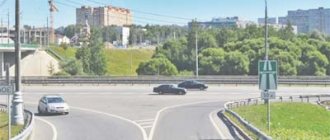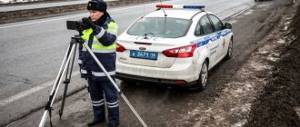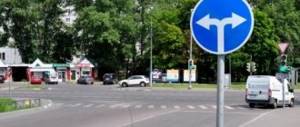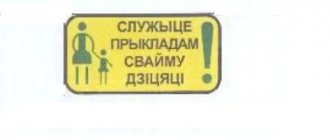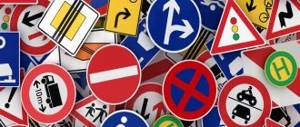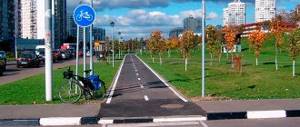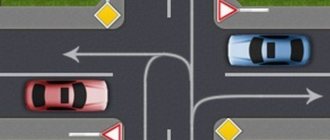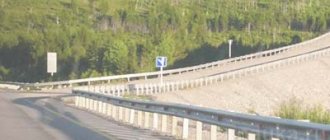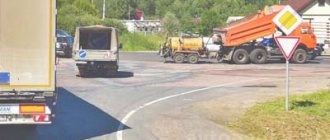Road signs and markings
There are several road signs in the current Regulations that relate to the regulation of cyclists.
Bike path / End of bike path
A "Bike Path" sign means you can only ride a bicycle
3. Sometimes you can walk along a bike path, but only if there is no sidewalk or pedestrian path nearby. At the same time, the pedestrian should not interfere with cyclists.
Footpath / End of footpath
“Pedestrian path” - only pedestrians
4, but if there is no bicycle path nearby, you can ride a bicycle, but without interfering with pedestrians.
Intersection with a bicycle path
The “Intersection with a bicycle path” sign warns drivers or pedestrians that there is a bicycle path ahead and they need to be extremely careful.
Bicycles are prohibited
If there is a “No Bicycles” sign along the roadway, then you are not allowed to ride there, regardless of whether there are obstacles on the sidewalk or bike path or not.
Road markings
“Bike path” markings are applied directly to the asphalt and show where to ride a bicycle:
Bike Lane
A “pedestrian path” is also drawn on the asphalt and shows where to walk:
Footpath
There are places in the city where you can walk and bike. It is designated as follows:
Path for joint movement of pedestrians and cyclists
The place where the bike path crosses the road looks like this:
The place where the bike path crosses the roadway
Where the bike path intersects with pedestrian paths or sidewalks:
Traffic rules and cyclists
Most lovers of two-wheeled transport do not consider themselves road users at all, and therefore do not follow the well-known traffic rules.
And this is a fundamentally wrong approach to your own safety and the lives of other people. According to the formulation, a bicycle is understood as a vehicle that has at least two wheels and is driven by the muscular power of the person driving the vehicle. Thus, it becomes clear that the bicycle driver is also a participant in the movement and must comply with all established rules. Keep in mind that some of the traffic rules are only suitable for motorists: these paragraphs usually refer to a mechanical vehicle (which a bicycle is not). But when the word “vehicle” or “driver” is mentioned, then rest assured that these points of the rules are most directly related to you.
What is prohibited for a bicycle driver?
Cyclists are prohibited from:
Move without holding the steering wheel with at least one hand. Adults, as a rule, use a bicycle for transport, while children ride it for pleasure. Especially stupid adults, when driving on the road, let go of the steering wheel and drive on with their arms crossed. If a cyclist falls, he will stretch out on the road surface along with the bicycle, which is why he may be hit by a nearby vehicle. Ride on sidewalks, pedestrian paths and pavements. Cyclists are still allowed to ride on the side of the road without interfering with passersby moving around or boarding public transport. Paths for pedestrians or sidewalks are intended only for passers-by, since when walking there, any individual must feel protected. Ride on the road
In this taboo lies attention to the safety and security of the cycling enthusiast. Turn left, turn along a highway with tram tracks or with multi-lane traffic in the indicated direction. If you need to turn or turn around, you must go to the pedestrian crossing, get off the bike and move to the other side of the passage. For other transport, take a bicycle in tow
A bicycle trailer with a rigid clutch is allowed to be transported by bicycle. Trying to ride while grabbing the edge of a truck often results in dramatic results. In this situation, the driver of the car does not see the hitched cyclist and does not worry about his safety. All cars drive at an approximate speed of more than sixty kilometers per hour. When avoiding potholes on the highway or hastily braking, an irresponsible cyclist ends up under the wheels of a car. Transport luggage that protrudes beyond the permissible parameters by more than half a meter and impedes coordination. Fishing gear, receivers, and any rods on bicycles interfere with a stable position, mainly when making turns. If a vehicle gets caught on protruding luggage, it can overturn a cyclist. Carry adults. Children aged 2 - 7 years old can only be ridden on an additionally attached seat with footrests. Transporting a person with a large body weight seriously violates the previously mentioned stable position.
Clothing is especially important for safe riding. It's not just about the bike helmet; however, ignoring it results in serious damage even in small falls.
Due to its small dimensions compared to a car and the complete silent ride, the amateur cyclist remains invisible on the road. And the lack of marker signals, reflectors, and bright clothing makes him invisible.
General traffic rules for cyclists
The basic provisions of the riding rules for cyclists are set out in Article 24 of the Traffic Regulations, but this is not the only mention of two-wheeled vehicles in the laws. Since 2014, the concept of “bicycle path” has appeared in the rules, and ideally, citizens using this type of transport should only ride along it (Article 24.1 of the Traffic Rules) and always move onto it if one appears in their field of vision. But in fact, they are only in large cities, like Moscow or St. Petersburg, and then on busy avenues. How to cope with this problem for residents of residential areas and small provincial towns will be discussed below.
According to Article 2.3 of the Traffic Regulations, before leaving, the bicycle driver must ensure that his vehicle is fully prepared for the trip: it has working brakes, steering wheel, chassis, inflated wheels, working light signals and a bell.
It is necessary to wear protective equipment such as a helmet or knee and elbow pads. There is no legal obligation for either children or adults to wear these things, and there will be no punishment for their absence, but elementary safety considerations have not been canceled. It is better to cover your eyes with special sports sunglasses.
Should he follow traffic rules?
A bicycle is officially equated to a type of vehicle and, for traffic regulations, is not much different from a car. For this two-wheeler, all the rules that begin with “The driver must…”, “The vehicle must…”, etc. apply. A bicycle does not belong to a mechanical vehicle, so if the test is about them, then it is not for cyclists.
For violations of traffic rules, the cyclist will bear administrative responsibility on an equal basis with other road users.
Expert opinion
Evgeniy Romanov
Lawyer, specializes in protecting rights in areas related to traffic rules, insurance and disputes with the traffic police.
There is a nuance that applies only to this type of transport: if a person gets off the saddle and stands on his feet, then officially he is already a pedestrian and obeys the rules for pedestrians.
Cyclist safety
Not everyone understands that a bicycle is equal to a car, so on the road a cyclist will need to follow the general rules of movement on the roadway (regarding non-motorized vehicles).
Let's look at what important factors need to be taken into account for the safe movement of cyclists.
Serviceability
Namely, check all the most important parts of the bicycle (handlebars, working brakes), check whether it is equipped with other important parts for driving on the highway:
- reflectors (back, front, and sides);
- flashlights that work at night;
- a working bell to sound a signal.
A cyclist must highlight his bicycle on the roadway so that both the vehicle and the driver himself are clearly visible to all other road users.
Road signs
- priority signs;
- signs of special instructions (informing about the movement of route vehicles, one-way traffic);
- signs that indicate the direction of movement;
- signs prohibiting turns and entry.
However, the cyclist must also know all other signs and strictly observe them. While driving, the bicycle driver should also take into account road markings:
- It is forbidden to cross a solid line;
- do not stand in places that are marked in yellow;
- allow pedestrians to cross the zebra crossing.
Also, the cyclist must move correctly in a group, be extremely attentive and have good reactions.
Speed
But on the road you should develop and maintain a fairly high speed, at least 20 km/h.
Sticking to this speed limit is necessary because driving too slowly can interfere with cars, as they will have to maneuver around the cyclist.
This is especially true on narrower roads, where passing oncoming and passing traffic is difficult.
It is worth noting that high speed is only justified if all other vehicles are moving quickly.
Distance
Side spacing is the distance across the width. Safe and comfortable riding on the road requires maintaining a distance and interval so that if a dangerous situation develops, the cyclist can turn to the side.
If the distance with the car in front decreases, you will need to slow down, or vice versa - speed up if the distance decreases with the vehicle behind.
In case of parallel movement, you should not press too close to parked or passing cars, and there are good reasons for this:
- There is a chance of falling on the car as a result of an uneven road.
- The car may hit the cyclist in some way.
- The door of a stationary car may suddenly open.
So, attentiveness is the key to safe cycling. In this case, you should carefully monitor what is happening on the sides and in front.
The road is movement, so the situation can change every second. It is useful to purchase a special rear-view mirror and attach it to the steering wheel, thanks to which you can also monitor the road from behind.
What is important to know to protect yourself on the roads
- Riding on the roads is dangerous because cyclists may not be seen at night. To prevent this from happening, it is recommended to wear brighter cycling clothing and equip your vehicle with reflective elements, as required by the rules for cyclists, section 6.2. The taillight must be turned on in accordance with paragraph 6.3 of the rules for cyclists. A bicycle light powered by a rechargeable battery or batteries is attached to the handlebars.
- A front light will help you spot vehicles from afar and illuminate the way.
- Often headlights have different functions: continuous glow, blinking.
- In order not to risk turning back, equip your mobile vehicle with a rear-view mirror, attaching it to the steering wheel. This simple accessory will help you focus your attention on the road.
- Another point of the rules aimed at preserving the health of the cyclist is the mandatory wearing of a helmet, which will protect the head in case of a fall, from which even an experienced driver is not insured. After all, circumstances do not always depend on his experience and skills.
Safe distance and interval: what do these indicators depend on?
Let's start by explaining what the terms “distance” and “interval” actually mean and how they differ. The distance should be understood as the distance maintained between two vehicles (the one in front/behind and the one moving behind/in front of it) while driving or when stopping (parking). The interval similarly implies a distance, only laterally from one vehicle to another vehicle.
A safe distance means maintaining a distance sufficient to completely stop the car in case of emergency braking (without colliding with another vehicle)
Here it is also important to pay attention to the car moving behind you and take this into account when braking.
Where can you ride?
This is a rather complex and conditional subtlety. The fact is that according to the Rules, as many as 7 different formal traffic zones are allowed for cyclists, depending on age and the organization of traffic in a given area.
Top articles: How to adjust the handlebars on a bicycle
Therefore, first we suggest that you find out where you can travel specifically in your case by interactively answering a few simple questions.
Over 14 years old
On bicycle paths and bicycle pedestrian paths or a lane for cyclists of your choice in any cases, if any, on the right side of the roadway: if there are no above zones or for one or another (objective) reasons it is impossible to ride on them if the width of your bicycle is more than 1 m (including
with cargo), if you are riding in a bicycle convoy,
on the side of the road, if there are no special paths or lanes for cyclists, and it is impossible or impossible to drive along the right edge of the roadway (note that the side of the road is not a roadway); at the same time, you must not interfere with pedestrians (they have priority on the side of the road), on the sidewalk or pedestrian zone, if all of the above is absent or there is no opportunity to drive along them - that is, in fact, this paragraph allows you to drive along pedestrian parks, alleys, etc. .P.; or if you are transporting a child under 7 years old or riding with a cyclist under 14 years old (clause 24.2 of the Rules)
The lane for cyclists is separated from the rest of the road by a solid line and is marked as follows:
And/or with a sign like this:
From 7 to 14 years
- Along the bike paths
- along bicycle and pedestrian paths,
- on the sidewalk,
- along the pedestrian path,
- along the pedestrian zone.
Any of the above is your choice.
Other changes for cyclists
Innovations have also been introduced in less significant adjustments to the Rules - basically, they are brought into line with other legal acts and between clauses of traffic rules.
It is prohibited to stop closer than 5 meters from the bike path
The list specifies exactly where stopping is prohibited for motorists, and this list includes bicycle and bicycle-pedestrian paths.
| Before changes | After changes |
| 12.4. Stopping is prohibited: in places where the vehicle will block traffic lights, road signs from other drivers or make it impossible for other vehicles to move (enter or leave) or interfere with the movement of pedestrians; | 12.4. Stopping is prohibited: in places where the vehicle will block traffic lights, road signs from other drivers or make it impossible for other vehicles to move (enter or exit) (including on bicycle or bicycle-pedestrian paths, as well as closer than 5 m from the intersection of a bicycle or bicycle-pedestrian path paths with the roadway) or will interfere with the movement of pedestrians (including at the junction of the roadway and sidewalk at the same level, intended for the movement of people with limited mobility); |
Cyclists are allowed through traffic in courtyards
Even before the changes, not all drivers knew about such a ban as driving through courtyard areas - that is, entering and leaving without stopping. Now cyclists have been excluded from this ban by changing clause 17.2.
Due to the virtual impossibility of getting caught for this traffic violation, this is perhaps one of the most useless innovations.
| Before changes | After changes |
| 17.2. Through traffic is prohibited in residential areas. | 17.2. Through traffic of motorized vehicles is prohibited in residential areas. |
Turning left on a multi-lane road was allowed.
. But provided that left turns and U-turns are allowed from the far right lane and if this road is outside the bicycle zone.
| Before changes | After changes |
| 24.8. Cyclists and moped drivers are prohibited from: turning left or turning around on roads with tram traffic and on roads with more than one lane for traffic in a given direction; | 24.8. Cyclists and moped drivers are prohibited from: turning left or turning around on roads with tram traffic and on roads that have more than one lane for traffic in a given direction (except when turning left from the right lane is permitted, and with the exception of roads located in bicycle zones) ; |
Hand gestures
In addition to light and sound signals, a system of hand gestures is also actively used on the roads for communication.
As a rule, first attracting attention with a short beep. Among such gestures there are symbols whose meaning is not always clear
Circle
When the driver draws a circle in the air with his index finger, he indicates that one of your tires is flat. Sometimes they use the "minor" gesture instead and point to a specific wheel.
Raised hand
Symbol of greeting or gratitude. This gesture is often responded to warnings or other signals from neighbors downstream, using it instead of flashing emergency lights.
Strike the air
When a passing driver mimes a punch in the air with the palm of his hand pointing down, he is telling you that the trunk or hood is open.
Hand placed on chest
A gesture of apology that is used when a person has done something wrong or behaved incorrectly on the road towards others.
Fig
A fig made from fingers is usually used to warn drivers of trucks or large buses that a stone is stuck between the paired wheels of one of the axles. This is a potential hazard for cars behind.
Don't forget that these are all unspoken signs that are not in the rules. They do not oblige you to anything and only express wishes. They do not have to be used, and in case of unpleasant situations, informal gestures cannot serve as an excuse. Only you are responsible for your actions!
Traffic controller signals for pedestrians
There are only 3 traffic controller signals in the traffic rules, but they have different meanings for different road users:
- pedestrians;
- Vehicle;
- trams
We will not consider traffic controller signals for trams in this article, but we will talk in more detail about pedestrians and vehicles.
So, if you see a traffic controller at an intersection, then the first thing you need to determine is who you are: a pedestrian or the driver of a vehicle (for example, a car or). After this, you need to determine by the traffic controller’s gestures whether you can move.
In paragraph 6.10 of the traffic rules, all traffic controller signals are described in the order they appear, however, in practice, a different approach is more convenient. After you have seen the traffic controller, you first need to understand what gestures he makes that allow you to move, without focusing on other road users. With the appropriate gesture, you will be able to continue moving.
Let's consider the traffic controller's gestures for pedestrians. Let me note that at an intersection a pedestrian can find himself in only two possible situations:
- you need to cross the road that goes to the right (red arrow);
- you need to cross the road that goes to the left (blue arrow).
Let the example pedestrian need to cross the roadway following the red arrow. A pedestrian can cross the road in the following situations:
- the traffic controller’s arms are extended to the sides (one to the left, the other to the right);
- The traffic controller's right arm is extended forward and he stands with his back to the side of the road that the pedestrian is about to cross.
In the left picture, the traffic controller’s arms are extended to the sides and the pedestrian can move along the red arrow
Please note that in this case the pedestrian's path intersects with the paths of cars turning right, but cars must give way to the pedestrian. In addition, the traffic controller with his arms extended to the sides can stand not only facing us, but also with his back. Traffic in this case will also be allowed
Movement in this case will also be allowed.
Movement along the blue arrow in the first picture is prohibited.
Let's look at the picture on the right. In it, the traffic controller has his back to us and his right arm is extended forward. In this case, you can also cross the road using the red arrow, but not the blue one.
Please note that if the traffic controller is facing us and his arm is extended forward, then the pedestrian’s movement along the red arrow is prohibited. So, approaching an intersection, a pedestrian should expect the following signals from the traffic controller: So, approaching an intersection, a pedestrian should expect the following signals from a traffic controller:
So, approaching an intersection, a pedestrian should expect the following signals from a traffic controller:
1. Arms extended to the sides. One hand shows the direction from which the pedestrian came, and the other hand shows the direction in which the pedestrian is going to continue his journey.
2. The traffic controller’s hand is extended forward. He stands with his back to the road that the pedestrian is about to cross.
Please note that if the traffic controller's arm is extended upward, pedestrian traffic is prohibited. However, since in practice the majority of pedestrians do not know the traffic controller’s signals, traffic police officers prefer to first stop the traffic flow by raising their right hand, and then show pedestrians with gestures that they can walk. This is not prohibited by the rules
This is not prohibited by the rules.
I note that for crossing the roadway at the wrong traffic signal, a pedestrian may be subject to an administrative fine, which will be considered later.
Road signs for cyclists: cycle path
We have already covered the most important sign for bicycle drivers. He is prohibitive. But there is another sign: it designates a bicycle path on which two-wheeled vehicle drivers can move freely.
Usually this sign is placed at the beginning of a specially designated asphalt strip; quite often it is marked with a picture of a bicycle. But keep in mind that markings without a special sign do not indicate a bicycle path. This lane refers to the main road surface on which motorists can also move.
The sign itself looks like a blue circle with a white bicycle in the background. According to the traffic rules, drivers of two-wheeled vehicles must first of all move on bicycle paths, and only if there are none, on the side of the road or the road surface.
Cyclist behavior model
The cyclist is obliged to know and follow the requirements of the traffic rules (traffic rules), traffic lights, signs, markings and follow the commands of traffic controllers.
This means that drinking alcohol while driving and talking on the phone while driving is prohibited. It is not allowed for a cyclist to turn on solid lanes or ride oncoming on a highway with traffic in one direction.
Technical requirements
- It is the responsibility of cyclists to maintain their personal bicycle transport in a defect-free technical condition. A bicycle with a functioning brake and a working horn. There is no need to explain why reliable brakes are needed. A bell is especially needed when warning passers-by about the proximity of bicycles. When driving among cars, it is unlikely that the driver will hear the bell.
- Driving in the dark on the highway or in rainy, foggy, snowy weather, in other words, in conditions of incomplete visibility, is allowed only with a light. In front of a bicycle, a flashlight or a light reflector is required, behind - a flashlight and certainly a red reflector, but on the sides (closer to the front and rear dimensions) - amber-colored lights or reflectors, in addition, red rear side lights are allowed. It is absurd and risky to have a red reflector ahead; car drivers rarely notice cyclists, and here, in addition, a kind of confusion is created.
Rules for safe behavior on the roads
- The bicycle driver moves as close as possible to the right side of the track, exclusively in one row with other cyclists.
- When overtaking another cyclist or horse-drawn vehicle, and avoiding stopped traffic, you still need to move away from the right edge of the highway. It is more correct to drive as far as possible around an obstacle, for example, a stopped car, since the driver will immediately begin to get out of it, swinging the door open, or an unseemly person will throw the half-smoked cigarette out of the window.
- Remember that you can only overtake on the left if you don’t want to be pressed against the curb.
Best articles: Mudguards for different types of bicycles and tips for choosing them
It is also the responsibility of the bicycle driver to give a warning notice before performing any maneuver if there is no vehicle nearby.
Before each turn or lane change and before braking, the cyclist must be warned with a gesture, and immediately when turning the steering wheel or pressing the brakes.
You need to warn the rear rider in time, otherwise your late reaction will become dramatic.
Cyclist signals
Traffic regulations allow the following hand signals:
- The signal for a right turn or change of formation is the left arm extended in the direction of the turn, or the right arm directed away from the body and bent at the elbow at an angle of ninety degrees.
- The signal for a left turn or change of formation is the right arm extended in the direction of the turn, or the left arm directed away from the body and bent at the elbow at an angle of ninety degrees.
- The gesture of braking is raised upward and the right or left arm is straight at the elbow.
Gesturing with your palm does not acquire a privilege in movement, therefore, you always need to be sure that the rear moving driver of the vehicle understands the plans of the cyclist and will not overtake.
If there is a bike path near the route, cyclists are required to move exclusively there. This is indicated by a spherical indicator symbol with a white bicycle on a blue tone.
If the bicycle path is partially destroyed, covered with construction materials, or there are cars parked on it, then the bicycle driver can go around these obstacles along the road, he is not prohibited from doing so.
When traveling abreast, cyclists must ride in only one column along the route, in groups of 10 people. The distance between groups is from eighty to one hundred meters to simplify driving around.
When driving in a group, they use coordinated signals that are sent not to car drivers, but to other cyclists riding behind.
A bump or obstacle on the right side - the right hand points downwards.
A bump or obstacle on the left side - the left hand points downwards.
Initially, these signs are introduced by the head of the cycling group, and other riders are required to immediately reproduce them. You should not wait until you reach a bump or rock on the highway. It is necessary to immediately signal the threat to cyclists moving behind.
Common Signals
Cyclists have the following conventional signals:
- To stop, raise your hand up.
- To indicate a left turn, you must extend your left arm straight in the direction of the turn or bend your right arm at the elbow.
- To turn right, you need to extend your right arm straight in the direction of the turn or bend your left arm at the elbow.
When cyclists ride in a large group, they exchange information about a danger such as a hole or some kind of obstacle on the road (a broken bottle, a stone, etc.). For this, the right hole represents the right hand extended downwards, and the left, respectively, the left. In this case, the leader gives the signal first, and everyone else in the chain points to the pit to the next participants in the movement. You need to signal in advance, as soon as you receive a signal from the cyclist ahead.
- Also, group movement of cyclists should not interfere with motorists. To do this, the column must be divided into groups of ten people and create a gap between them for overtaking cars equal to eighty to one hundred meters.
- one call - attention to danger, you need to slow down;
- two calls - someone doesn’t make it in time, you need to slow down;
- three calls - emergency stop, something happened.
Conditioned signals that indicate a turn are recommended to be given using straight outstretched arms. Motorists are already accustomed to this.
Signals given by the cyclist must be indicated well in advance of the maneuver, approximately 3-5 seconds before the turn. But you should stop signaling after completing the maneuver; this rule does not apply in situations where signaling interferes with the cyclist’s actions; in these cases, the turn stops showing right before it is completed.
When driving in a group, you can develop your own symbols among yourself, for example, to indicate danger or for an emergency stop. If suddenly the person at the back of the column begins to lag behind, what should he do in such a situation? Therefore, you can use a sound or light signal. The light has many disadvantages: during the day it is not visible, and at night on the highway in the light of cars, the leader of the column cannot always understand that it is you who are giving him a signal - you are blinking the light. And everyone can hear the sound and pay attention to it. For example, you can use the following signals:
You can also use conventional signs with your hands, for example, an arm extended to the side with an open palm signals danger and the need to reduce speed. But a hand clenched in a fist means an emergency stop. Ride with pleasure and don't forget that everything you do is important for safety on the road.
Prohibitions
The main prohibitions are:
- drive “hands-free”, especially when driving among pedestrians;
- do not carry volumes that lengthen or expand the dimensions of the vehicle by more than 0.5 meters;
- carry passengers if the design feature of the bike does not allow this;
- transport preschoolers in places that are not equipped for them with child seats or in the absence of them;
- transport the bicycle in tow.
When traveling on a bicycle of any design, you should strive not so much to blindly follow the rules of the road, but to be attentive to other road users. Sometimes, it is better to show restraint and let a road bully pass than to prove your priority to him at the cost of your own health.
Restrictions and prohibitions
There are many prohibitions and restrictions, the implementation of which is mandatory. If you don't ride your bike according to the rules, there will be chaos that will lead to chaos on the roads.
Riding a bicycle is prohibited if there is a problem with the brake system. You also cannot:
- Carry in an additional seat a passenger whose age exceeds 7 years.
- Hold onto another bicycle (or other vehicle) with your hands while moving.
- Drive without holding the steering wheel with your hands, periodically removing your feet from the pedals.
- Be in a drunken state while driving.
- Transport cargo that protrudes 40–50 cm in front, behind or on the sides if it interferes with driving a bicycle or driving other vehicles.
- Transport people in the absence of a special place.
- Driving without a helmet on the highway.
- Talk on your mobile phone while holding it in your hands (only talking using headphones or Bluetooth is allowed).
- Drive on highways or on roads intended for cars, carriageways (if there is a bicycle path).
- Tow other two-wheeled vehicles (with the exception of a trailer designed for a bicycle).
Turning a bicycle to the left or making a U-turn if there is a tram track in the middle is also prohibited. Here you will have to get off the bike, carry it in your hands along the zebra crossing and continue moving in the right direction.
At a pedestrian crossing, a cyclist must get off his vehicle and walk across the road.
Riding will be safe only if you travel in accordance with the traffic rules for bicycles. It is allowed to drive a vehicle with reflectors (red at the back, white at the front, orange at the sides) and a built-in bell (horn).
In the evenings, at night and during fog, a flashlight is required. In the absence of the above, cycling around the city is unacceptable. Regardless of where exactly and on what side of the road the cyclist is moving. There may be no signal or reflectors on bicycles for children (under 7 years old). In this case, one of the parents takes control of what is happening.
General provisions[edit]
A bicycle is defined as “a vehicle, other than a wheelchair, having two or more wheels and generally propelled by the muscular power of its occupants, which may have an electric motor of up to 0.25 kW (rated), switching off when exceeding 25 km/h" (traffic rules 1.2). A cyclist, according to the Rules, qualifies as a bicycle driver. After the introduction of a clarifying amendment, “Pedestrians are considered persons ... who use roller skates, scooters and other similar means for transportation.” (Clause 1.2 of the Traffic Regulations) bicycles, as a rule, include means that have a drive to the wheel, and are not driven by direct pushing of the pedestrian from the road surface.
A bicycle is a vehicle, but is only a "motor vehicle" if it can be propelled by a motor. Therefore, if the traffic rules say “vehicle,” then this applies to all bicycles, and if it says “motor vehicle,” then this applies to bicycles with a motor that is structurally capable of driving the vehicle.
If a person does not ride a bicycle, but drives it, then he is considered a pedestrian, not a cyclist (Traffic Rules 1.2). In general, he is equivalent to a pedestrian carrying a bulky load, and therefore can use the edge of the roadway. But at the same time, the Rules stipulate one difference between a dismounted cyclist and a pedestrian: according to clause 4.1 of the traffic rules, “Outside populated areas, when moving on the roadway, pedestrians must walk towards the movement of vehicles,” but “Persons ... driving ... a bicycle must follow in the direction of travel
Vehicle". Movement along the roadsides has no such restrictions.
Persons at least 14 years of age are allowed to ride a bicycle when traveling on roads (Traffic Regulations 24.1).
According to the state standard for the classification of vehicles, electric bicycles with a motor power of more than 250 W are mopeds, which is why they are subject to appropriate age restrictions that set the minimum age for driving a moped at 16 years (SDA 24.1). Also, the driver of an electric bicycle must wear a fastened motorcycle helmet (Traffic Regulations 24.3), and from the end of 2013 he will need to have a driver’s license of category M or any other category. However, electric bicycles that have an engine with a power not exceeding 0.25 kW and that automatically switches off at speeds over 25 km/h are not mopeds (SDA 1.2)
What you need to know
Before starting to learn road signs, a cyclist should take a number of measures:
- study road signs in detail, despite the fact that they are mostly intended for cars, the cyclist should also know the rules for overtaking, prohibiting and permitting signs;
- know that after the rider gets off the vehicle, he becomes a pedestrian and must follow the traffic rules specifically for this category;
- in case of heavy traffic, driving on the roadway in the evening and at night, it is necessary to install reflective symbols and lights on the bicycle; if the rider rides with a backpack, it must be marked with reflective signs;
- We should not forget about our own protection - helmet, glasses, gloves;
- The brake system of the bicycle must be in good working order in order to ensure safe braking if necessary;
- You should take a pump and a spare bladder with you.
When entering the roadway, the cyclist becomes a full participant in the road traffic, in accordance with paragraph 1.2 of the traffic rules.
Fines
A bicycle, like other road users, is a vehicle when moving on public roads. However, the administrative code removes them from the list of classic vehicles.
Therefore, another article of the Code of Administrative Offenses 12.29 applies to them, which regulates liability and fines for violating current traffic rules.
Thus, a sanction for non-compliance with any traffic rules entails a fine of 800 rubles. At the same time, the amount of the fine for driving while drunk is already about 1,500 rubles.
It is worth noting that any violations of a cyclist are recorded on video, similar to violations of ordinary car drivers.
Today, the practice of regulating compliance with traffic rules by this type of transport has not yet been established.
Therefore, many cyclists often ride as they please.
The only thing that is controlled today is their movement on highways, where traffic police officers are always present and, if necessary, can stop the vehicle in case of violation and issue a fine.
Fines for cyclists who do not comply with the laws
Since the Code of Administrative Offenses does not classify bicycles as vehicles, the punishment is different. For cyclists, Article 12.29 of the Code of Administrative Offenses of the Russian Federation applies. Where are the fines for non-compliance with traffic rules?
For example, violation of traffic rules by a bicycle rider will entail payment of a fine of 500 rubles. If the cyclist was drunk, then the fine increases to 1000 - 1500 rubles (Administrative Code Art. 12.29, paragraph 2, 3).
Traffic rules for cyclists: general provisions
To begin with, it is worth mentioning that a bicycle is a vehicle driven by human muscular power, and the cyclist himself, according to the rules, is considered the driver of a two-wheeled vehicle.
A dismounted cyclist carrying a bicycle at his side is considered a pedestrian with a load, and can use not only the sidewalk, but also part of the roadway for transportation. In the latter case, it is necessary to move along the opposite edge of the roadway, towards the flow of cars.
Riding a bicycle is allowed from the age of fourteen - on bicycle paths, bicycle zones along the road and pedestrian sidewalks.
The movement of cyclists aged 7 to 14 years should be carried out only on sidewalks, pedestrian, bicycle and pedestrian paths, as well as within pedestrian zones.
Traveling in a convoy of cyclists also has its own restrictions and rules.
For example, riding on the roadway in only one row, a column of cyclists is allowed to move in two rows if the overall width does not exceed 0.75 m, the column should be divided into groups of no more than 10 people, and the distance between them should be 80-100 meters to make it easier for vehicles to overtake.
When riding in the dark, the cyclist must have reflective elements on his clothing, and the bicycle is equipped with a rear marker light and an additional front light to illuminate the path.
Where is it allowed to travel?
All cyclists should know how to ride correctly and which side of the road this can be done on. If there are no specially designated places, you can ride a bicycle on the roadway along with cars, but on the right or on the side of the road.
How to ride a bicycle on the road in convoys - here drivers must split up in groups (no more than 10 people in one). The distance between them should be about 100 meters. Cyclists in a convoy usually ride one after the other without disturbing others.
If there is a special path, then you need to go along it. If it intersects outside the intersection with the road, then you will have to move off last, behind all the vehicles that move along it.
Little cyclists ride on sidewalks only under adult supervision. Riding a bicycle on the sidewalk is also allowed in cases where there are no shoulders or special paths.
What will be the violation?
To make it easier to imagine the size of fines, keep in mind that the basic amount as of 01/01/2019 in Belarus is 25.50 rubles (approximately 12 US dollars).
Responsibility10 for violating traffic rules will overtake you in the following forms:
- Violation in a sober state and without victims - a warning or a fine from 1 to 3 basic units.
- If you violated the rules while under the influence of alcohol or drugs - a fine of 3 to 5 basic units. The same fine may be imposed for refusing to undergo a test for intoxication.
- If the violation led to the creation of an emergency situation - a fine of 3 to 8 basic units, and if it caused minor bodily injury or damage to property - a fine of 5 to 25 basic units. The same amount of fine faces the person who left the scene of an accident in which he became a participant.
Best articles: Reviews of ardis bicycles
From practice, we can say that admitting guilt helps to obtain the minimum fine, although in each specific case the decision is made individually.
A collision between a cyclist and a pedestrian is not considered a traffic accident, and in this case, if necessary, you should call the police, not the traffic police.
In Belarus, there is a law that confiscates cars from drivers who are caught driving while intoxicated two or more times. Fortunately, this does not apply to bicycles, and they cannot take a bicycle away from a drunken cyclist, even if they catch him in this state several times. But this is not a reason to drive drunk!
Do not violate traffic rules, drive your bike carefully, respect yourself and others. Not to avoid fines, but to make the city a comfortable and safe environment for everyone.
The next post is even more interesting: How to ride among pedestrians.
Stay with us - Urbanoid on Telegram, VK, , Instagram and Strava!
Drunk driving on a bicycle
Most cyclists believe that their movement cannot entail any liability. However, in reality this is not the case.
Today, regulatory authorities are gradually beginning to pay more attention to bicycle traffic rules. According to the law, there is liability for drunk driving, and a bicycle is a vehicle. Therefore, the rules explicitly prohibit driving drunk.
Despite the fact that a similar article is also suitable for cyclists, and employees have the right to hold such drivers accountable, in practice the situation is somewhat different.
Thus, driving a bicycle does not require a special driver’s license, which makes it impossible to deprive them of it.
Therefore, an article in the Code of Administrative Offenses of the Russian Federation is applied, which determines the level of responsibility of drivers.
Important! Driving a scooter or moped while drunk is fully covered by the article for vehicle drivers and penalties under it are also legal.
Moving along the roadway
Once you have become comfortable with driving a bicycle and learned the basic rules of the road, you can ride out onto the roadway. It is better if these are quiet streets with little traffic, until it becomes clear how drivers behave when a bicycle approaches, and their own speed of reaction to unexpected situations.
The rules require driving on two wheels only on the far right side of the lane. But parked cars force you to maneuver into the middle of the road. Such detours should be carried out only with an eye on the traffic coming behind. A sharp drive to the middle of the road can take the driver by surprise; in addition, the inertia of the car is much higher than that of a bicycle.
Another danger that lurks in such a situation is the suddenly opening door of a parked car on the driver’s side. Before the maneuver, the cyclist is in the “blind spot” and cannot be seen from the driver’s seat. Therefore, it is better to perform the maneuver with a margin of distance.
On busier streets, the right lane is reserved for city traffic, and the sidewalks are filled with people waiting for their bus. In such a situation, many cyclists follow closely behind cargo and passenger transport and, having become accustomed to the monotony of traffic, do not have time to react to its stop.
It is important to keep your distance and remain vigilant, as sometimes public transport stops at the request of passengers in places not intended for this purpose
By the way, a similar situation arises when driving behind a freight vehicle. Massive vehicles completely block the view of the traffic lane, and a sudden stop of the car, due to a red traffic light or any other traffic situation, can result in a collision.
Driving in a straight line will not cause any difficulties even with minimal driving skills. When driving to complex road junctions, you need serious experience and knowledge of the rules of the road. If you are not confident in fully mastering the rules and fluently reading the traffic situation, then the best way out is to get off the bike and cross the pedestrian crossing. In the case of a left turn at a difficult junction, the traffic rules leave no choice at all, obliging you to become a pedestrian for a while.
Cyclists are prohibited
- Driving a vehicle without hands on the steering wheel - reckless driving and driving with just your legs are unacceptable;
- Drive with a load that extends beyond the dimensions by more than 0.5 meters in any direction or interferes with control;
- Transport passengers on a frame, on a trunk or in any other way that is not provided for by the design;
- Transport a child without a specially equipped seat;
- Drive along pedestrian crossings;
- While in the right traffic, turn around or turn left on tram lines, or on a highway with two or more lanes - unless there is a special sign on the road allowing a turn or if the road does not pass in a special bicycle zone;
If you urgently need to turn left, you can get off your bike and, like an ordinary pedestrian, cross to the other side of the road along the zebra crossing, driving traffic nearby.
- Tow another bicycle (if there is no special towing trailer on which another vehicle is securely attached);
- Drive on highways;
- Talk on the phone while holding the steering wheel with one hand.
Signs of special regulations
- 5.1 Motorway
- 5.2 End of the motorway
- 5.3 Road for cars
- 5.4 End of the road for cars
- 5.5 One-way road
- 5.6 End of a one-way road
- 5.7.1 Entering a one-way road
- 5.7.2 Entering a one-way road
- 5.8 Reverse movement
- 5.9 End of reverse movement
- 5.10 Entering a road with reverse traffic
- 5.11.1 Road with a lane for route vehicles
- 5.11.2 Road with a lane for cyclists
- 5.12.1 End of the road with a lane for route vehicles
- 5.12.2 End of road with bicycle lane
- 5.13.1 Entering a road with a lane for route vehicles
- 5.13.2 Entering a road with a lane for route vehicles
- 5.13.3 Entering a road with a lane for cyclists
- 5.13.4 Entering a road with a lane for cyclists
- 5.14 Lane for route vehicles
- 5.14.1 End of lane for route vehicles
- 5.14.2 Cyclist lane
- 5.14.3 End of the bicycle lane
- 5.15.1 Lane directions
- 5.15.2 Lane directions
- 5.15.3 Start of strip
- 5.15.4 Beginning of the middle section of a three-lane road
- 5.15.5 End of lane
- 5.15.6 The end of the section of the middle strip on a three-lane road intended for traffic in this direction.
- 5.15.7 Lane direction
- 5.15.8 Number of lanes
- 5.16 Bus and (or) trolleybus stop location
- 5.17 Tram stop location
- 5.18 Taxi parking area
- 5.19.1 Pedestrian crossing (installed on the right)
- 5.19.2 Pedestrian crossing (installed on the left)
- 5.20 Artificial hump
- 5.21 Residential area
- 5.22 End of residential area
- 5.23.1 Beginning of a settlement
- 5.23.2 Beginning of a settlement
- 5.24.1 End of a populated area
- 5.24.2 End of a populated area
- 5.25 Beginning of the settlement
- 5.26 End of a settlement
- 5.27 Restricted parking zone
- 5.28 End of restricted parking zone
- 5.29 Regulated parking zone
- 5.30 End of regulated parking zone
- 5.31 Speed limit zone
- 5.32 End of speed limit zone
- 5.33 Pedestrian zone
- 5.34 End of the pedestrian zone
- Traffic fines, payment Check traffic police fines
- Unpaid fines
- Paid fines
- My cars
- My license/drivers
- Penalty table
- Help with fines
- Traffic rules
- OSAGO calculator
- Check KBM
- Road accident
- Get rights
